Fort Titus
Introduction
Text-to-speech Audio
Known as "Fort Titus, this is a replica of a fortified cabin that was a site of retribution by Free State men following the 1856 attack on Lawrence. The actual site of the skirmish was about two miles south of this current historical landmark at a site selected for its proximity to other landmarks related to the history of Lecompton and Bleeding Kansas. Residents of Kansas Territory generally tried to avoid the controversies related to the issue of slavery's extension, but after the attack on the largely Free State community of Kansas, the proslavery settlers led by Henry Titus soon found their presence even more intolerable. Titus had illegally claimed the land two miles south of this marker while a Free State settler was away, and the attack on his cabin and his fellow proslavery partisans forced them from the area which further cemented the area's reputation as a place controlled by Free Staters.
Images
Colonel Henry Theodore Titus Oil-painting
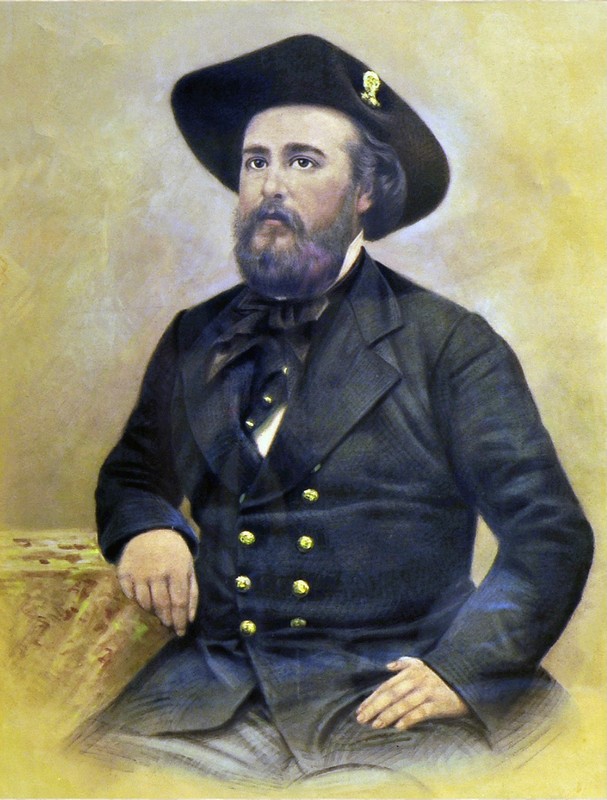
Oil Painting depiction of Battle of Fort Titus
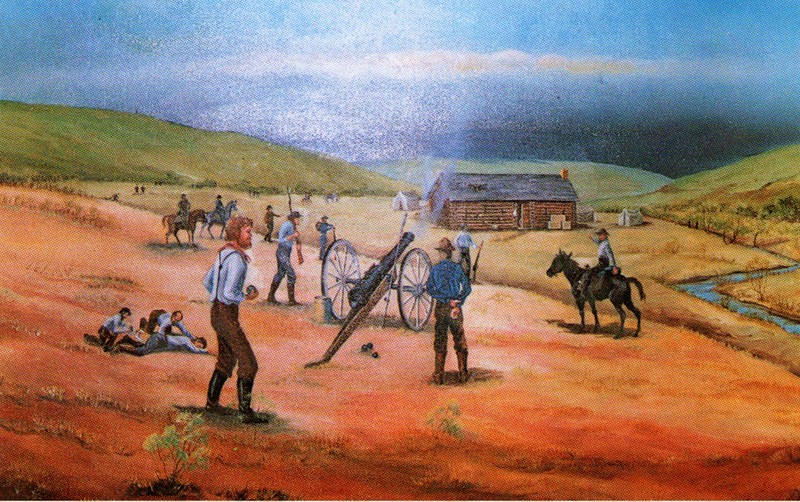
Original location of Fort Titus
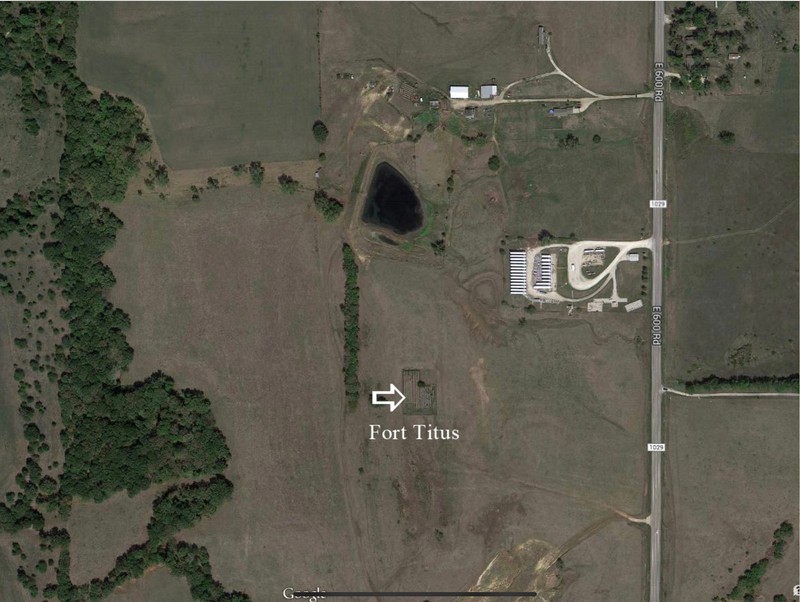
Original Douglas County Map, and location of Fort Titus (in red)
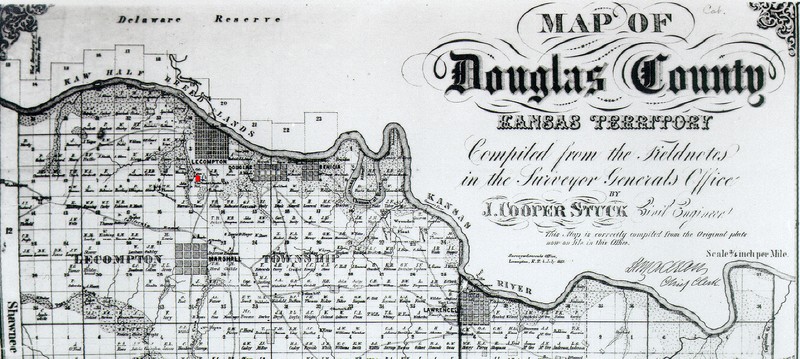
Depiction of the end of the Battle of Fort Titus
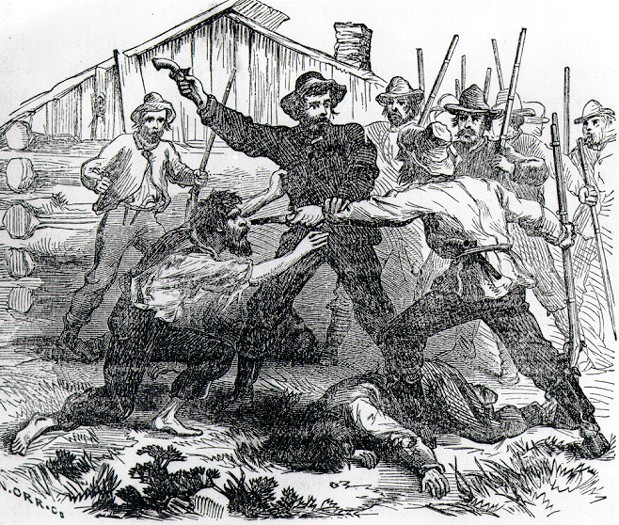
“Old Sacramento” cannon used by Free State Militia at Battle of Fort Titus
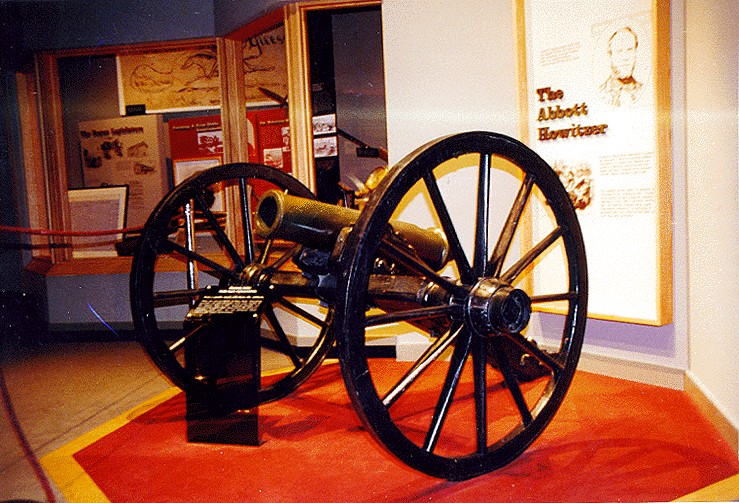
Fort Titus Memorial
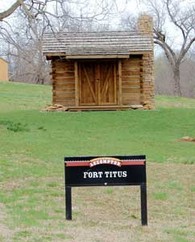
Fort Titus Memorial Plaque
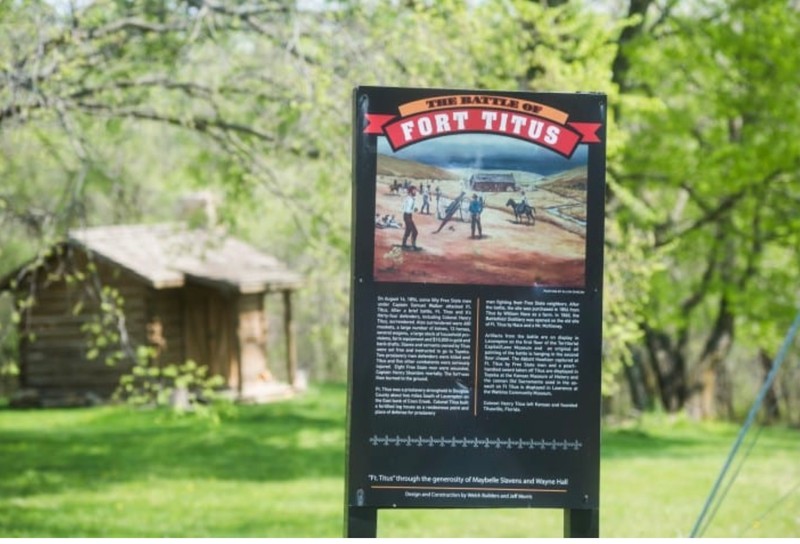
Henry T. Titus Headstone
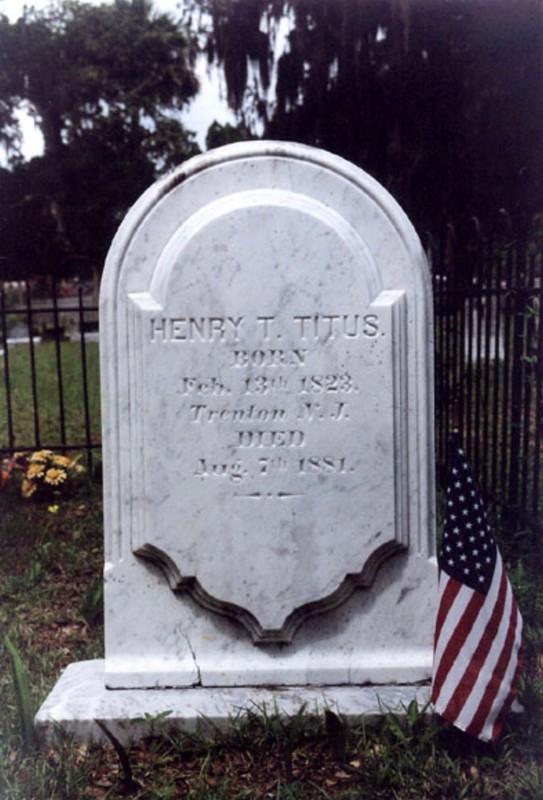
Titusville, Florida burial place of Henry T. Titus and Family
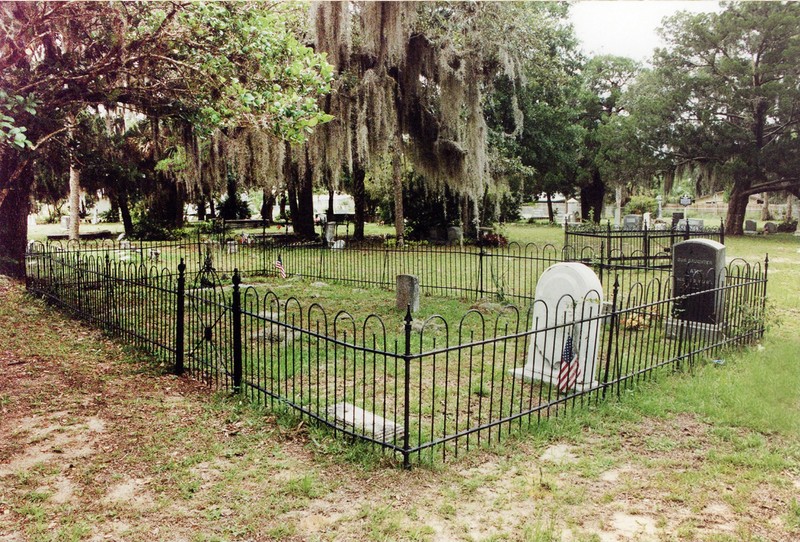
Cannon Balls From “Old Sacramento”
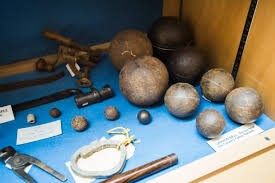
Backstory and Context
Text-to-speech Audio
Fort Titus was originally located two miles south of Lecompton on the banks of Coon Creek, and was built on land of a Free Stater while he was away by Henry Titus, a Southerner who supported slavery. The cabin was later moved to this location and established as a historic site thanks to the Wayne and Maybelle Slavens Hall Fund.
Henry T. Titus initially came to Kansas to back pro-slavery efforts in the Kansas territory following the 1854 action by the federal government to officially allow settlers and hold elections to decide if Kansas Territory would permit slavery. What would later be known as "Fort Titus" was a fortified log cabin built on land stolen by Henry T. Titus from a many with the last name of Smith. After burning Smith’s home to the ground, Titus created a cabin he believed would serve as base of operations for other pro-slavery men of the Kansas territory to stage raids against other Free Staters. Instead, Fort Titus was destroyed by Free State men on August 16th, 1856, partially in retribution for the Sack of Lawrence on May 21, 1856.
The attack came in the aftermath of the 1856 Sack of Lawrence under the command of Free State leader Jim Lane, who first led Free State men to another fortified cabin known as "Fort Franklin," which was just a few miles south of Lawrence. There they captured an artillery piece they would dub “Old Sacramento.” Jim Lane then set his sights on the fortified log cabin owned by Colonel Henry Theodore Titus. Jim Lane sent for reinforcements from Lawrence and left command of the Free State militia to his friend Samuel Walker. Captain Walker led a contingent of nearly fifty men to fight against Colonel Henry T. Titus and his pro-slavery partisans at Fort Titus.
On August 16th,1856, the battle of Fort Titus commenced. Free State partisans quickly realized the ineffectiveness of their rifles on the fortified log cabin and brought the cannon they named “Old Sacramento” to bear, firing six times and inflicting heavy damage and casualties. The battle was brief, and Titus surrendered. He later told a newspaperman: “I was shot in three places, my house was burned. I was thrown into an uncovered wagon, dripping with blood, and dragged through the blazing sun to Lawrence, the great den of thieves” (Hebel, 1969). The captured pro-slavery men under the command of Col. Titus were arrested and brought back to Lawrence and released following a prisoner exchange (Hebel, 1969).
Along with the capture of Col. Titus’s pro-slavery men was an accompaniment of four hundred muskets, “a large number of knives,” “A large stock of household provisions,” “farm equipment,” and nearly $10,000 USD (1856 USD value) in “gold and bank drafts” (The Civil War Muse). Following its capture, Free State men burned the fort to the ground (Hebel, 1969). In February of 1857, Titus arrived at San Juan del Norte (present-day Nicaragua) to command roughly 180 filibusters who attempted a failed conquest. Titus perished in 1881 in the state of Florida. The land where Fort Titus had once stood was purchased as a farm by William Nace who would later open the “Battlefield Distillery” on the site of the old Fort Titus.
Sources
1. Kansas, Lecompton. “Battle of Fort Titus.” Lecompton Kansas, 16 Apr. 2015, https://lecomptonkansas.com/learn/fort-titus/.
2. Cova, Antonio R. de la. “Col. Henry Theodore Titus .” Henry Theodore Titus, University of South Carolina Press , 2016, http://www.latinamericanstudies.org/titus.htm.
3. De La Cova, Antonio Rafael. “Curran on De La Cova, 'Colonel Henry Theodore Titus: Antebellum Soldier of Fortune and Florida Pioneer'.” H-War, Air War College, Apr. 2018, https://networks.h-net.org/node/12840/reviews/1767430/curran-de-la-cova-colonel-henry-theodore-titus-antebellum-soldier
4. Blackmar, Frank W. Kansas: A Cyclopedia of State History .. ii, Standard Pub. Co., 1912.
5. The Civil War Muse a Grawader Enterprises website - www.thecivilwarmuse.com. “The Civil War Muse.” The Civil War Muse - The Battle of Fort Titus, http://www.thecivilwarmuse.com/index.php?page=fort-titus
6. Capps, Kriston, and Vinson Cunningham. “Kehinde Wiley's Anti-Confederate Memorial.” The New Yorker, The New Yorker , 24 Dec. 2019, https://www.newyorker.com/culture/culture-desk/kehinde-wileys-anti-confederate-memorial.
7. Mushko , Becky. “A Missing Nace Brother.” Peevish Pen, https://peevishpen.blogspot.com/2008/09/mising-nace-brother.html.
8. Alexander , Kathy. “Franklin, Kansas.” Legends of Kansas, https://legendsofkansas.com/franklin-kansas/.
9. Lecompton, Historic. “Constitution Hall.” Lecompton Kansas, 16 Apr. 2015, https://lecomptonkansas.com/learn/constitution-hall-state-historic-site/
10. O’Brien , Tony. “Civil War on the Western Border: The Missouri-Kansas Conflict, 1854-1865.” Jayhawkers | Civil War on the Western Border: The Missouri-Kansas Conflict, 1854-1865, https://civilwaronthewesternborder.org/encyclopedia/jayhawkers
11. Philips , Christopher. “Civil War on the Western Border: The Missouri-Kansas Conflict, 1854-1865.” Lane, James Henry | Civil War on the Western Border: The Missouri-Kansas Conflict, 1854-1865, https://civilwaronthewesternborder.org/encyclopedia/lane-james-henry.
12. Society , Kansas Historical. “Charles Robinson.” Kansas Historical Society, https://www.kshs.org/kansapedia/charles-robinson/11739.
13. Society , Kansas Historical. “John Brown.” Kansas Historical Society, https://www.kshs.org/kansapedia/john-brown/11731.
14. To History , Eye Witness. “The Sack of Lawrence, Kansas, 1856.” The Sack of Lawrence, Kansas, 1856, Eye Witness to History , http://www.eyewitnesstohistory.com/lawrencesack.htm
15. Ward, Carolyn. “Samuel Walker .” 1918 KS & Kansans, Samuel Walker, http://www.ksgenweb.org/archives/1918ks/biow/walkers.html.
16. History.com Editors. “Bleeding Kansas.” History.com, A&E Television Networks, 27 Oct. 2009, https://www.history.com/topics/19th-century/bleeding-kansas.
17. Hebel, Iantho Bond. “Colonel Titus - Latin American Studies.” Colonel H. T. Titus, Founder of Titusville, Florida, N/A, http://www.latinamericanstudies.org/filibusters/Colonel-Titus.pdf.
Cova, Antonio R. de la. “Col. Henry Theodore Titus .” Henry Theodore Titus, University of South Carolina Press , 2016, http://www.latinamericanstudies.org/titus.htm.
Cova, Antonio R. de la. “Col. Henry Theodore Titus .” Henry Theodore Titus, University of South Carolina Press , 2016, http://www.latinamericanstudies.org/titus.htm.
Cova, Antonio R. de la. “Col. Henry Theodore Titus .” Henry Theodore Titus, University of South Carolina Press , 2016, http://www.latinamericanstudies.org/titus.htm.
Cova, Antonio R. de la. “Col. Henry Theodore Titus .” Henry Theodore Titus, University of South Carolina Press , 2016, http://www.latinamericanstudies.org/titus.htm.
Cova, Antonio R. de la. “Col. Henry Theodore Titus .” Henry Theodore Titus, University of South Carolina Press , 2016, http://www.latinamericanstudies.org/titus.htm.
Cova, Antonio R. de la. “Col. Henry Theodore Titus .” Henry Theodore Titus, University of South Carolina Press , 2016, http://www.latinamericanstudies.org/titus.htm.
https://www.legendsofamerica.com/fort-titus-kansas/
https://www.legendsofamerica.com/fort-titus-kansas/
Cova, Antonio R. de la. “Col. Henry Theodore Titus .” Henry Theodore Titus, University of South Carolina Press , 2016, http://www.latinamericanstudies.org/titus.htm.
Cova, Antonio R. de la. “Col. Henry Theodore Titus .” Henry Theodore Titus, University of South Carolina Press , 2016, http://www.latinamericanstudies.org/titus.htm.
http://www.freedomsfrontier.org/Visitors/Sites/Comments.aspx?id=115
